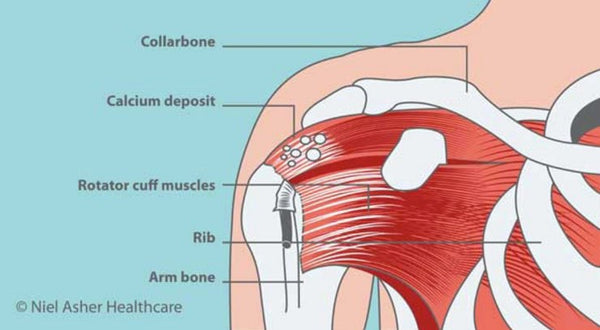Posted by Simeon Niel Asher on Oct 09, 2016

In most cases, calcific tendonitis can be treated using non-surgical means.
If you’re experiencing stiffness and shoulder pain and it’s making it hard for you to sleep at night, you could have Calcific Tendonitis. With this condition, 1-2 centimeter deposits of calcium form in the tendons of the rotator cuff. As the calcium accumulates, the area becomes very tender and it is difficult to lift your arm without experiencing pain and stiffness.
The pain is typically felt around the rotator cuff muscles (usually supraspinatus) and is often misdiagnosed as frozen shoulder syndrome. The good news is that in most cases, calcific tendonitis can be treated using non-surgical means.
Causes
Calcific Tendonitis often develops as a result of overhead activities like playing tennis or house painting. When muscles and tendons rub against one another over and over again, it can cause inflammation. Calcium then develops as part of the body’s attempt to repair this damage. Poor posture is another common cause and there is a growing school of thought that some metabolic diseases of the parathyroid glands in the neck may generate extra calcium.
Very often the cause is simply a cyclical process that occurs over time, leading to a build up of calcium. During the day, regular arm movements may shut off some of the blood flow to the supraspinatus muscle. Then, when you are resting or sleeping at night blood flows back into the area to compensate. This cyclical pattern may cause calcific tendonitis to develop over time.
Very often the cause is simply a cyclical process that occurs over time, leading to a build up of calcium. During the day, regular arm movements may shut off some of the blood flow to the supraspinatus muscle. Then, when you are resting or sleeping at night blood flows back into the area to compensate. This cyclical pattern may cause calcific tendonitis to develop over time.
Stages of Calcific Tendonitis
Calcific tendonitis exists in two different forms. With Degenerative Calcification, calcium accumulates in weak, run-down tendons that develop as we get older. Reactive Calcification, on the other hand, progresses through a series of stages:
In the Pre-Calcification Stage, you don’t experience any symptoms. At this point, the tissue in the area where the calcium will develop goes through cellular changes.
In the Calcific Stage, calcium comes out of the cells and forms into deposits. At this point, the calcium looks like chalk. There is a Resting Phase, where you will experience no pain. During the Resorptive Phase, the pain returns and can become quite excruciating. At this point, the calcium is the consistency of toothpaste.
Finally, in the Post-Calcific Stage, the calcium disappears and is replaced by the normal rotator cuff. At this point, the pain goes away.
Although there are a number of stages, it is not always a long process. In some cases, the condition is resolved in about 4 weeks.
In the Pre-Calcification Stage, you don’t experience any symptoms. At this point, the tissue in the area where the calcium will develop goes through cellular changes.
In the Calcific Stage, calcium comes out of the cells and forms into deposits. At this point, the calcium looks like chalk. There is a Resting Phase, where you will experience no pain. During the Resorptive Phase, the pain returns and can become quite excruciating. At this point, the calcium is the consistency of toothpaste.
Finally, in the Post-Calcific Stage, the calcium disappears and is replaced by the normal rotator cuff. At this point, the pain goes away.
Although there are a number of stages, it is not always a long process. In some cases, the condition is resolved in about 4 weeks.
Calcific tendonitis is seen most often in people between the ages of 30-50, and more often in women than in men. People who have diabetes are more susceptible to developing the condition.
Location of calcium deposits
Calcium is most frequently deposited in the rotator cuff of the shoulder. The following are the most common areas where we find calcium deposits (Stefani 2009):
- Supraspinatus muscle - 80%
- Infraspinatus muscle - 15%
- Subscapularis muscle - 5%
Treatment
Aggressive treatment is not recommended in the acute phase (which usually lasts 3-5 days) as it can stir-up the already active condition. There are however, gentle hands-on techniques that NAT therapists can use to help reduce the acute symptoms.
Once the acute phase has settled down it doesn’t mean the calcium has gone away and in fact many people are left with some shoulder stiffness as the calcium will stay in the shoulder tendons until it is removed or is slowly reabsorbed.This stiffness can be rapidly and effectively treated with NAT.
Calcium Deposits
Silent calcium deposits that are also common. These calcium deposits can be re-activated with overhead or vigorous activities such as swimming or tennis. It is not uncommon to have silent phases of 1-2 years between the acute episodes. Your manual therapist or NAT practitioner will advise you on what you can do to prevent further episodes and reduce severity as soon as the twinges appear.
Simeon Niel Asher is a british osteopath and acknowledged creator of the Niel Asher Technique (NAT), the only clinically proven manual therapy technique for treating frozen shoulder and other complex musculoskeletal conditions. NAT techniques are used daily by over 60,000 doctors and healthcare workers worldwide.
Комментариев нет:
Отправить комментарий